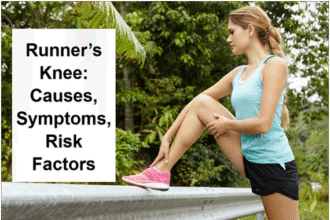Patellofemoral pain syndrome is pain in the front of the knee and around your kneecap. The condition is often referred to as a runner’s knee. It is more frequent in runners and other athletes in running and jumping sports.
The knee pain usually comes on when a person is running, climbing stairs, squatting, or sitting for a long period of time. It is easier to resolve or prevent runner’s knee if you know why it occurs.
About Runner’s Knee
Runner’s knee produces pain in the front section of the knee close to the patella. The predominant reason for runner’s knee occurs from irritation impacting both the cartilage and soft tissues located behind the patella. Certain motions can make the pain worse, particularly if the knees are bent for a long time.
Common Causes for Runner’s Knee
Runner’s knee can develop as a result of several factors, such as:
1. Overuse
Repetitive knee movements like running and jumping create strain on the joint and supporting tissues, which results in irritation and soreness.
2. Weakness or Imbalance of the muscles
Weak or unbalanced thigh/hip/core muscles may impact the kneecap position. Pain can also be experienced during movement when the kneecap firmly moves out of its normal track.
3. Knee Injury
Direct trauma to the kneecap, from a fall or a direct hard bump, might cause inflammation or a misalignment that creates the pain.
4. Earlier knee surgery
Some people can get runner’s knee after surgery, particularly surgery that involves the kneecap or ligaments.
Symptoms of Runner’s Knee
The most common symptom is a feeling of dull and aching pain in the front of the knee. This is something one might notice mainly during:
- Climbing or going down stairs
- Kneeling or squatting
- Prolonged sitting with the knees bent, such as on a chair or in a car
- After physical activities involving the legs
You may also hear a popping sound or feel grinding when bending the knee.
Who is at Risk?
Some factors increasing the incidence of runner’s knee include the following:
- Age – Runner’s knee is seen more frequently in the teen and young adult populations.
- Sex – There is a higher incidence in females than in males, likely due to greater differences in muscle strength and hip strength.
- Physical activity – People who have an active lifestyle of running, jumping, or other high-impact activities, such as athletes, are at high risk.
- Foot and leg alignment – Flat feet, overpronation (inward rolling) of the feet, or poor weight-bearing are also potential causes.
Diagnosis of Runner’s Knee
During the knee examination, your health care provider will ask about your symptoms and activity level while reviewing your past injury history. Your health care provider will assess the movement of your knee, together with the function of your muscles.
If needed, the following imaging study may be conducted in certain situations:
- X-rays – Help detect a bone problem.
- MRI – Displays soft tissue injury, including cartilage or tendon.
- CT scan – Analyzes bone and soft tissue with a finer detail view.
- Ultrasound – Checks for tendon problems with sound waves.
Treatment Options for Runner’s Knee
Most cases can be treated without surgery. Common non-surgical options include:
1. Rest and Activity Modification
Do not do anything that places an additional burden on your knee, such as deep squats or climbing stairs. During your recovery, try low-impact exercises like biking or swimming.
2. Ice Therapy
Icing the knee for 15-20 minutes every day, a few times a day, lowers swelling and pain.
3. Over-the-Counter Pain Relief
Medications such as ibuprofen or acetaminophen may assist in pain and inflammation management.
4. Physical Therapy
A physical therapist may guide you with exercises to:
- Strengthen hip and thigh muscles
- Improve knee alignment
- Stretch tight muscles
- Correct movement patterns
They may also recommend taping, bracing, or orthotics if needed.
5. Surgery (in some cases)
If other treatments fail to help, a physician might propose surgical procedures which might include:
- Arthroscopy: A minimally invasive procedure in which a small camera is used for repair.
- Kneecap Realignment: A surgical procedure can, in some circumstances, be needed for repositioning of the kneecap. You can easily get a good knee pain treatment in Delhi.
Preventing Measures for Runner’s Knee
It is impossible to prevent all cases of knee pain; however, you may reduce your chances of it by doing the following:
- Do leg and hip exercises. Pay attention to the exercises that support your knees.
- Make a joint preparation of at least 5 minutes before your exercise.
- Stretch regularly to keep your joints, calves, hamstrings, and thighs tight.
- Consult a physical therapist or trainer before indulging in running or sports.
- Wear good shoes that will protect your knees and cushion your exercise.
- In order to become resistant to overtraining, you should gradually increase your stamina through less strenuous workouts.
- Being healthy weight reduces knee strain.
Conclusion
Runner’s knee is prevalent among athletic people, but it’s usually addressed with rest, physical therapy, and minor lifestyle adjustments. You can move without knee pain if you are aware of the causes, symptoms, and preventative methods.
It is a good idea to ask a medical expert to conduct a thorough examination in case your knee pain persists or recurrently comes back. You should seek the best orthopedic doctor in Indiaeasily for your knee treatment.







